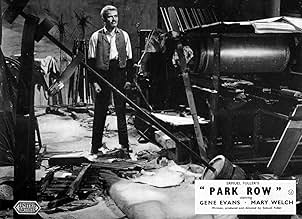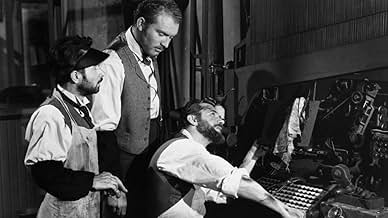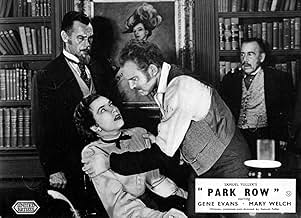The Globe is a small, but visionary newspaper started by Phineas Mitchell, an editor recently fired by The Star. The two newspapers become enemies, and the Star's ruthless heiress Charity Ha... Read allThe Globe is a small, but visionary newspaper started by Phineas Mitchell, an editor recently fired by The Star. The two newspapers become enemies, and the Star's ruthless heiress Charity Hackett decides to eliminate the competition.The Globe is a small, but visionary newspaper started by Phineas Mitchell, an editor recently fired by The Star. The two newspapers become enemies, and the Star's ruthless heiress Charity Hackett decides to eliminate the competition.
- Jenny O'Rourke
- (as Tina Rome)
- Barfly
- (uncredited)
- Barfly
- (uncredited)
- Irate Liberty Fund Contributor
- (uncredited)
- Barfly
- (uncredited)
- Director
- Writer
- All cast & crew
- Production, box office & more at IMDbPro
Featured reviews
Our story proper begins in that most Fuller-ish of places, a saloon. There, a bunch of hacks on New York's bestselling daily, The Star, spends their evenings swilling booze and exchanging dreams and bitter bon mots. When idealistic reporter Gene Evans takes a break from the bar to nail an epitaph to the grave of an executed man that reads 'Murdered by The Star' – an acerbic bolt of pure fury from Fuller that's among the neatest things he ever did – the 'paper's owner (Mary Welch) marches in, sacking him and his chums on the spot.
So Evans starts up the 'paper he's always dreamt of – The Globe – and cheery, impressionable young buck George O'Hanlon throws himself off the Brooklyn Bridge for a laugh, giving him a first-rate first splash. But Welch doesn't take such competition lying down, especially not from a man she quite fancies, and so begins a circulation war that spills over into resentment, hatred and good old-fashioned violence.
As you would expect, Fuller has a real feel for the material, filling his script with the usual insider terminology and slang. Leaving just enough in his account for some vodka and cigars, the writer-director-producer spent the rest of his savings – some $200,000 accrued making hit war films – on this pet project. Much of the cash went on a fastidiously complete recreation of the Park Row of his memory, including a multitude of four-storey buildings. The film's designers queried his logic, saying the tops of the structures would never be seen on camera. Fuller said he didn't care: "I had to see it all. I had to know everything was there, exact in every detail." The sets are constructed in an ingenious way that allows Fuller's camera to wind his way through the nooks and crannies of the offices, the intensity of the shooting schedule belied by the wealth of innovation behind the camera. The director's crab dolly, a wheeled platform that allowed the camera to move in any direction, aids the spectacular direction, getting us up close and personal during Evans' periodic stomps up and down the titular street, generally looking for someone to thump.
Park Row is a punchy, sometimes dynamic blend of heartfelt sentiment and acerbic cynicism that could only have come from one director. Whilst it occasionally appears over-earnest or self-congratulatory, and has too much repetition across its 80 minutes, it's flavourful and immersive, with a no-name cast that ideally suits its ink-stained universe.
Park Row is the street to the east of New York City's City Hall and it only runs three short blocks. But back in 1886 several papers of the tabloid variety had their offices and printing establishments there. This film Park Row is the story of two of them where the feuding got downright personal.
Mary Hackett who is a real queen of mean fires a whole bunch of her staff over editorial policy disagreement including Gene Evans who takes the fired workers and starts his own tabloid. He gets a super big break when George O'Hanlon playing the legendary Steve Brodie makes his famous dive off the Brooklyn Bridge and Evans gets the bead on the story first. After that Hackett fights and fights real dirty. She especially doesn't like the fact that Evans has spurned her.
Samuel Fuller directed this admirable B film with a cast of no real names, but that in itself gives it a realistic look. That look is at an era that is gone, but not forgotten. By the way another look at this same era can be seen in the film Newsies which is currently on Broadway now.
Still without the singing and dancing of Newsies, I think Park Row will give you an idea of what was going on during those times.
I doubt that Fuller was ever well-budgeted. He made do, and boy did he.
The office of the paper is a tight web of cubicles (that are torn down at one point) that cast dark shadows and patches of light. Fuller allows his camera to capture repeated black and white shadow portraits of the characters, their emotion forming the full frame of a shot.
At other points, the camera tours the tiny den as characters move through it as if it were dancing a marvelous ballet Outside is a square, statues of Benjamin Franklin and Horace Greeley and a narrow street allegedly populated by newspapers.
This is all Fuller has to work with, but he makes it work so that even though your subconscious is saying, well, that doesn't look quite realistic, your movie viewing buys in and ignores the tells, absorbing the essence of the scene. Terrific film craft, more than just cinematography.
Can't argue the storyline is up to the filmmaking, but there are touches that Fuller sprinkles throughout that are marvelous.
The newly found paper buys its paper from the butcher. On the floor is a box of unsorted type. It took me back to junior high school in upstate New York, where for a marking period, we had print shop and learned to sort our type and grab it to compose a line in a hand-held device.
There's Otto Morgenthaler, a character borrowed from history, who actually did invent the linotype machine and first use it at the New York Tribune, which is referred to as a competing paper in the film.
The statue of Benjamin Franklin is still there, at the end of Park Row. At one time, the street held The New York World in the Pulitzer Building, Greeley's New York Tribune, The New York Times at #41, the Mail and Express, the Recorder, the Morning Advertiser, and the only other survivor, The Daily News at #25.
In the story, set in 1880s, AP is referred to. The concentration of papers eventually led to the Associated Press, located on Park Row, but that wasn't until 1900.
In the next decade, the landscape was dramatically altered with the construction of the Brooklyn Bridge. It not only cast its shadow over Park Row, but also caused some of its buildings to be demolished for ramp space to the bridge.
Why were the newspapers all there? Strangely, it's never mentioned in the film. Park Row is right around the corner from City Hall, the NYC Police Headquarters and the financial district. That's a pretty good nexus for news.
This one doesn't pop up very often. If you find it, watch and enjoy.
(My ratings are usually to the next highest star. In this case, about 7.5)
This is a completely fictional story, but it incorporates enough truth to be confusing. In the 1880s Park Row was newspaper row in New York City. There was a campaign that looks like crowdfunding today to finance the pedestal for the Statue of Liberty so the monument could be completed. There was an Ottmar Mergenthaler who invented the linotype machine, the first device that could easily and quickly set complete lines of type for use in printing presses. But all of these things did not take place under one roof for one newspaper. The film does have a pretty accurate depiction of newspaper printing as it occurred in the late 1800s, and that is the most interesting aspect of it.
I could deal with the confusion, but then there is the ham fisted romance/ sexual tension between The Star's Charity Hackett and The Globe's Phineas Mitchell. It reminded me of Hill Street Blues' romance between police captain Frank Furillo and public defender Joyce Davenport - If these two people really believe in what they are doing, how could they ever be attracted to one another? But then I am showing my age to explain a 70 year old movie in terms of a 40 year old TV show.
Overall, I'd recommend it. This was a passion project for Sam Fuller as he used his own money to produce it. Just be prepared for it to be a bit of an uneven ride.
Did you know
- TriviaDirector Samuel Fuller put up his own money to make the movie and lost it all.
- GoofsApproximately 20 minutes into the film, there's a wall calendar showing the date as "1886 June 15 Monday." In 1886 June 15 was a Tuesday.
- Quotes
Phineas Mitchell: The press is good or evil according to the character of those who direct it.
- Crazy creditsInstead of "The End", the picture ends with "Thirty"; newspaper jargon for "that's all. There ain't no more!"
- ConnectionsFeatured in The Typewriter, the Rifle & the Movie Camera (1996)
- How long is Park Row?Powered by Alexa
Details
Box office
- Budget
- $200,000 (estimated)
- Runtime1 hour 23 minutes
- Color
- Sound mix
- Aspect ratio
- 1.37 : 1
Contribute to this page


































